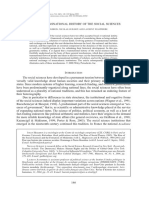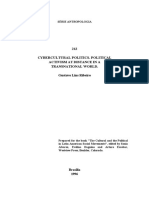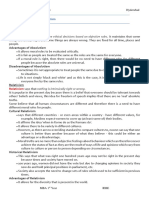Steven Vertovec Transnationalism
Steven Vertovec Transnationalism
Uploaded by
tytrackCopyright:
Available Formats
Steven Vertovec Transnationalism
Steven Vertovec Transnationalism
Uploaded by
tytrackOriginal Description:
Original Title
Copyright
Available Formats
Share this document
Did you find this document useful?
Is this content inappropriate?
Copyright:
Available Formats
Steven Vertovec Transnationalism
Steven Vertovec Transnationalism
Uploaded by
tytrackCopyright:
Available Formats
BOOK REVIEWS
STEVEN VERTOVEC. Transnationalism. London and New York: Routledge, 2009.
Pp. 205. ISBN: 978-0-415-43298-6 (hardback); ISBN: 978-0-415-43299-3
(paperback).
In an endeavor to grasp the realities of people living in an era dominated by phenomena
described as globalization, researchers from various academic backgrounds seem to find
comfort in applying the concept of transnationalism to their studies. In particular,
transnationalism has become a key concept used in migration studies, thanks to the
anthropological works of academics like Glick Schiller et al. (1992). Steven Vertovec, who
is a trained anthropologist himself, currently working as the director of the Max-Planck
Institute for the Study of Religious and Ethnic Diversity in Göttingen, Germany, takes up
the challenge to provide an overview on the various topics that have been studied in relation
to migrant Transnationalism. This compact book, which is divided into an introduction
followed by five chapters organized around specific topics and a conclusion, provides an
excellent initiation to the key ideas of transnationalism for students and due to its
comprehensiveness and its multi-disciplinary approach, this book is also an inspiring source
for academics who are already established in this field of studies.
In the introduction Vertovec offers a detailed overview of academic discussions
surrounding the concept of transnationalism. To bring some clarification to this concept,
he starts by making a differentiation between ‘inter-national’ and ‘transnational’ activities.
According to his definition the former refers to interactions between national governments,
which would include amongst others formal agreements and diplomatic relations, while
the latter describes a “sustained and ongoing exchange among non-state actors based across
borders” (p. 3; cf. Portes 2001a cited in Vertovec 2009: 29). Vertovec emphasizes throughout
his book (see for example pp. 29, 147) the importance of being clear and specific about the
usage of concepts such as transnationalism and diaspora. Otherwise, academics run the
risk of stepping into conceptual “muddy water” (p. 136), in which a concept like
transnationalism, for instance, can loose its heuristic value for highlighting limited and
distinct social processes (Portes 2003: 876).
But the theory of transnationalism has also been criticized by scholars who consider it
an overused conceptual framework, which in addition implies an approach that strengthens
the model of the nation state, rather than moving beyond it (p. 17). While such criticism
does not erode the concept’s general usefulness, it helps to reflect on the unpolished aspects
surrounding the theory of transnationalism, according to Vertovec. One way of refining
transnational theory and simultaneously grasping the heterogeneity of transnational activities
that vary across immigrant communities (Portes 2003: 879) would be to focus on the
modes, levels, extents and impacts of transnationalism; to categorize the transnational
migrants themselves (return migrants, retirement migrants, refuges and asylum seekers
and so on); and to concentrate on the degrees of mobility relating to transnational practices
and orientation (p. 18–19).
In chapter two, Vertovec focuses on the elaboration of some theoretical approaches and
sociological concepts, like ‘social networks’ and ‘social capital’, for example, which he
considers helpful for the analysis and understanding of migrant transnationalism. In the
84 Suomen Antropologi: Journal of the Finnish Anthropological Society
34(3) Autumn 2009
PO Box 59, 00014 University of Helsinki, Finland
BOOK REVIEWS
five subsequent chapters he then goes on to examine how transnationalism effects people’s
thinking and acting, and how such processes can cause ‘significant transformations’ of
structures within the socio-cultural, political, economic and religious spheres (p. 24). The
migration process and a transnational lifestyle can alter, for example, culturally constructed
gender roles and structures. Thus, several studies seem to suggest that migration can improve
the social status of women, who as a consequence of migration gain “access to employment
and a certain degree of control over income and material resources” (p. 65). In the religious
sphere, women seem to take on a more significant role in community associations than
they used to before migration (p. 139). Often transnational lifestyles also turn people into
true cosmopolitans, who are able to “switch codes” (Roger Ballard 1994 cited p. 73)
according to context, thus managing the multiplicity of meanings they encounter in their
lives. As Vertovec points out in chapter four, migrating people have also influenced the
political sphere and caused nation states to rethink their policy of dual citizenship and
citizenship rights in general. Furthermore, transnationalism engages with emerging economic
transformations through the sending of remittances, for example.
Transnationalism belongs to a Routledge series called Key Ideas, which intends to provide
critically written books dealing with a variety of topics that are central in the realm of
social science. And indeed, Vertovec is successful in communicating to his audience in a
lively manner the key ideas surrounding the concept of transnationalism. Echoing Vertovec,
however, this book could have benefited from an even more precise definition of the concept
of transnationalism as understood and used by the author. In this context, a clear explanation
by the author of why and how he distinguishes between migrant transnationalism and
other forms would have been useful.
REFERENCES
................................................................................................................................................................
Glick Schiller, Nina, Linda Basch and Christina Blanc-Szanton 1992. Transnationalism: A New Analytical
Framework for Understanding Migration. In Glick Schiller, Basch and Blanc-Szanton (eds), Towards a
Transnational Perspective on Migration: Race, Class, Ethnicity and Nationalism Reconsidered. New York: New
York Academy of Science.
Portes, Alejandro 2003. Conclusion: Theoretical Convergences and Empirical Evidence in the Study of Immigrant
Transnationalism. International Migration Review 37 (3): 874–892.
Warner, R. Stephen and Judith G. Wittner 1998. Gatherings in Diaspora: Religious Communites and the
New Immigrant. Philadelphia: Temple University Press.
LAURA HIRVI
UNIVERSITY OF JYVÄSKYLÄ
laura.j.hirvi@jyu.fi
Suomen Antropologi: Journal of the Finnish Anthropological Society 3/2009 85
You might also like
- Green TaraDocument125 pagesGreen TaraFladrif100% (8)
- Cultural GlobalizationDocument16 pagesCultural Globalizationee0785No ratings yet
- Precis - Grassroots Globalisation and The Research Imagination, Arjun AppaduraiDocument5 pagesPrecis - Grassroots Globalisation and The Research Imagination, Arjun AppaduraiShree Ram SubediNo ratings yet
- Islam and LogosDocument100 pagesIslam and LogosLUCAS MARTINS100% (1)
- Conceptualizing Simultaneity A TransnatiDocument38 pagesConceptualizing Simultaneity A TransnatiBatatão silvaNo ratings yet
- Vertovec StevenDocument25 pagesVertovec StevenThaysa de Miranda RodriguesNo ratings yet
- Levitt, Glick-Schiller - 2004 - Conceptualizing Simultaneity A Transnational Perspective On SocietyDocument38 pagesLevitt, Glick-Schiller - 2004 - Conceptualizing Simultaneity A Transnational Perspective On SocietyKeveen Del Refugio Escalante100% (1)
- Conceptualizing Simultaneity: A Transnational Social Field Perspective On SocietyDocument39 pagesConceptualizing Simultaneity: A Transnational Social Field Perspective On SocietyPatrícia Tavares de FreitasNo ratings yet
- Globalization, Transnationalism, Diasporas Facing New Realities and Conceptual Challenges. Judith Bokser JDocument19 pagesGlobalization, Transnationalism, Diasporas Facing New Realities and Conceptual Challenges. Judith Bokser JSusana HaugNo ratings yet
- Transnationalism - Schiller and LevittDocument39 pagesTransnationalism - Schiller and Levitttrevorjohnson515No ratings yet
- 336-Article Text-421-1-10-20150819 PDFDocument22 pages336-Article Text-421-1-10-20150819 PDFsarahNo ratings yet
- Lost (Andfound?) in Translation:Feminisms InhemisphericdialogueDocument18 pagesLost (Andfound?) in Translation:Feminisms InhemisphericdialogueLucas MacielNo ratings yet
- Critique of Arjun Appadurai - HarryDocument10 pagesCritique of Arjun Appadurai - Harryhirakhatri100% (1)
- Introduction, Towards A Cross-Disciplinary History of TheDocument10 pagesIntroduction, Towards A Cross-Disciplinary History of TheRose BlackpinkNo ratings yet
- Ardic - Friend or Foe, Globalization in TurkeyDocument26 pagesArdic - Friend or Foe, Globalization in TurkeyadityarahmanfadNo ratings yet
- Ideology Censorship and Translation Across Genres 241007 165410Document7 pagesIdeology Censorship and Translation Across Genres 241007 165410ssergg795No ratings yet
- Schiller & Salazar (2013) Regimes of Mobility Across The GlobeDocument19 pagesSchiller & Salazar (2013) Regimes of Mobility Across The GlobeMiguel Ángel JiménezNo ratings yet
- Globalization and Culture - The Three H ScenariosDocument19 pagesGlobalization and Culture - The Three H ScenariosWilly WonkaNo ratings yet
- Mandaville - Reading The State From ElsewhereDocument9 pagesMandaville - Reading The State From ElsewhereAvi FigueroaNo ratings yet
- 1-New Keywords Migration and BordersDocument34 pages1-New Keywords Migration and BordersMaria V. Martínez GonzálezNo ratings yet
- Migration, Society and Globalisation: Introduction To Virtual IssueDocument6 pagesMigration, Society and Globalisation: Introduction To Virtual IssueLucianoDalcolVianaNo ratings yet
- Traduzindo Moda, Linguagem (2021)Document22 pagesTraduzindo Moda, Linguagem (2021)Pollyana BernardesNo ratings yet
- We Are Intechopen, The World'S Leading Publisher of Open Access Books Built by Scientists, For ScientistsDocument19 pagesWe Are Intechopen, The World'S Leading Publisher of Open Access Books Built by Scientists, For ScientistsMidz SalipNo ratings yet
- Frank and AminDocument24 pagesFrank and Aminpubgmobile298adiNo ratings yet
- Scholten, Pisarevskaya, Levy, An Introduction To Migration Studies: The Rise and Coming of Age of A Research FieldDocument22 pagesScholten, Pisarevskaya, Levy, An Introduction To Migration Studies: The Rise and Coming of Age of A Research FieldromainNo ratings yet
- Rüsen - Some Theoretical Approaches To Intercultural Comparative HistoriographyDocument19 pagesRüsen - Some Theoretical Approaches To Intercultural Comparative Historiographyamira.romoNo ratings yet
- Translation, Interpretation and Intercultural CommunicationDocument18 pagesTranslation, Interpretation and Intercultural CommunicationnataNo ratings yet
- Sheffer On DiasporasDocument26 pagesSheffer On DiasporasderpmilitantNo ratings yet
- WERNER, M ZIMMERMANN, B. Beyond Comparison - Histoire Croisée and The Challenge of Reflexivity PDFDocument25 pagesWERNER, M ZIMMERMANN, B. Beyond Comparison - Histoire Croisée and The Challenge of Reflexivity PDFmvclageNo ratings yet
- Duke University Press Is Collaborating With JSTOR To Digitize, Preserve and Extend Access To Boundary 2Document31 pagesDuke University Press Is Collaborating With JSTOR To Digitize, Preserve and Extend Access To Boundary 2mmaialenNo ratings yet
- Bailey 2001Document4 pagesBailey 2001berkeaccNo ratings yet
- More Multi, Less CulturalismDocument21 pagesMore Multi, Less CulturalismluciargentinaNo ratings yet
- HEILBRON. Toward A Transnational History of The Social Sciences PDFDocument15 pagesHEILBRON. Toward A Transnational History of The Social Sciences PDFLucasTrindade88No ratings yet
- Drouhot 2023 Fitting in at The Top Stigma and The Negotiation of Belonging Among The New Immigrant Elite in FranceDocument28 pagesDrouhot 2023 Fitting in at The Top Stigma and The Negotiation of Belonging Among The New Immigrant Elite in FrancedjlenutNo ratings yet
- The Dawn of Everything A New History of HumanityDocument5 pagesThe Dawn of Everything A New History of HumanityhiendangkyNo ratings yet
- GOODY The Logic of Writing and The Organization of SocietyDocument4 pagesGOODY The Logic of Writing and The Organization of SocietyPaulo VictorNo ratings yet
- Transnational PerspectivesDocument19 pagesTransnational PerspectivesAsilatul Hanaa AbdullahNo ratings yet
- Oxford University Press, American Historical Association The American Historical ReviewDocument23 pagesOxford University Press, American Historical Association The American Historical ReviewEiriniEnypnioNo ratings yet
- 9 - Teorias de La GlobalizacionDocument17 pages9 - Teorias de La GlobalizacionLaura Daniela Garcia YazoNo ratings yet
- The Challenge of OrientalismDocument20 pagesThe Challenge of OrientalismpermafrostXxNo ratings yet
- Searching For An Appropriate Research Strategy On Transnational MigrationDocument21 pagesSearching For An Appropriate Research Strategy On Transnational MigrationThaysa AndréiaNo ratings yet
- UntitledCHRISTINA SCHÄFFNER TRANSLATION AND INTERCULTURAL COMMUNICATION: SIMILARITIES AND DIFFERENCESDocument19 pagesUntitledCHRISTINA SCHÄFFNER TRANSLATION AND INTERCULTURAL COMMUNICATION: SIMILARITIES AND DIFFERENCES9370201049No ratings yet
- 212 Cybercultural Politics. Political Activism at Distance in A Transnational World. Gustavo Lins RibeiroDocument31 pages212 Cybercultural Politics. Political Activism at Distance in A Transnational World. Gustavo Lins RibeiroMRCALNo ratings yet
- Seeing Like A State - James C. ScottDocument31 pagesSeeing Like A State - James C. ScottFernanda WerneckNo ratings yet
- Read The Cultural Other Forms of Otherness in The Discourses of Hong Kong's DecolonizationDocument256 pagesRead The Cultural Other Forms of Otherness in The Discourses of Hong Kong's DecolonizationjoannaNo ratings yet
- Conceptualizations of Development and Underdevelopment - The Works of Frank and Amin PDFDocument24 pagesConceptualizations of Development and Underdevelopment - The Works of Frank and Amin PDFAnushka AnandNo ratings yet
- Andrew Heywood, Pp. 560.: Global Politics, Palgrave Macmillan 2011Document2 pagesAndrew Heywood, Pp. 560.: Global Politics, Palgrave Macmillan 2011RizwanNo ratings yet
- Gullestad InvisibleFencesEgalitarianism 2002Document20 pagesGullestad InvisibleFencesEgalitarianism 2002gabriletta001No ratings yet
- Displacement and Testimony - Recent History and The Study of ExileDocument23 pagesDisplacement and Testimony - Recent History and The Study of ExilePanchis 13No ratings yet
- Translation As A Cultural World System - HeilbronDocument19 pagesTranslation As A Cultural World System - Heilbronlily. zNo ratings yet
- Schaeffner - Translation and Intercultural CommunicationDocument30 pagesSchaeffner - Translation and Intercultural CommunicationMarcos Petre100% (1)
- ReviewDocument6 pagesReviewserah ndiranguNo ratings yet
- (The Politics of Intersectionality) Angelia R. Wilson (Eds.) - Situating Intersectionality - Politics, Policy, and Power-Palgrave Macmillan US (2013)Document221 pages(The Politics of Intersectionality) Angelia R. Wilson (Eds.) - Situating Intersectionality - Politics, Policy, and Power-Palgrave Macmillan US (2013)noizatuNo ratings yet
- New Hybridities Old Concepts The Limits of CultureDocument24 pagesNew Hybridities Old Concepts The Limits of Culturemaxsoto3011No ratings yet
- Embodied Violence and Agency in Refugee Regimes: Anthropological PerspectivesFrom EverandEmbodied Violence and Agency in Refugee Regimes: Anthropological PerspectivesSabine Bauer-AminNo ratings yet
- UntitledDocument277 pagesUntitledYali Li100% (1)
- Mapping The Limits of Multiculturalism I PDFDocument22 pagesMapping The Limits of Multiculturalism I PDFRouie Rance IrlandezNo ratings yet
- Within Between Above and Beyond Pre Positions For A History of The Internationalisation of Educational Practices and KnowledgeDocument18 pagesWithin Between Above and Beyond Pre Positions For A History of The Internationalisation of Educational Practices and KnowledgeZenaideCastroNo ratings yet
- Walter Mignolo InterviewDocument28 pagesWalter Mignolo InterviewVeronica TelloNo ratings yet
- Envisioning the World: Mapping and Making the GlobalFrom EverandEnvisioning the World: Mapping and Making the GlobalSandra HoltgreveNo ratings yet
- What Is History For?: Johann Gustav Droysen and the Functions of HistoriographyFrom EverandWhat Is History For?: Johann Gustav Droysen and the Functions of HistoriographyNo ratings yet
- Masculinities Ageing between Cultures: Relationality, Kinship and Care in DialogueFrom EverandMasculinities Ageing between Cultures: Relationality, Kinship and Care in DialogueHeike HartungNo ratings yet
- Critique PaperDocument2 pagesCritique PaperMariel CadayonaNo ratings yet
- Reflective Writing and Critical Thinking Unit - 1 Imdad Baloch M.A English and M.Phil in Education (Continue)Document50 pagesReflective Writing and Critical Thinking Unit - 1 Imdad Baloch M.A English and M.Phil in Education (Continue)Ambreen ArshadNo ratings yet
- Cambridge University Press American Society of Church HistoryDocument49 pagesCambridge University Press American Society of Church HistoryLucasNo ratings yet
- Spinoza's DistinctionDocument13 pagesSpinoza's DistinctionJoan Cordero RedondoNo ratings yet
- Anthem Study QuestionsDocument4 pagesAnthem Study Questionschels97939836100% (4)
- What Is Jurisprudence Definition by AustDocument8 pagesWhat Is Jurisprudence Definition by AustSrinivas 513No ratings yet
- 1talmy L Toward A Cognitive Semantics Concept Structuring Sys PDFDocument558 pages1talmy L Toward A Cognitive Semantics Concept Structuring Sys PDFusmezuly100% (1)
- 1 Absolutism Vs RelavatismDocument4 pages1 Absolutism Vs Relavatismvenku ballariNo ratings yet
- Thematic Translation Installment 109 Chapter Ad-DukhaanDocument12 pagesThematic Translation Installment 109 Chapter Ad-Dukhaani360.pkNo ratings yet
- Fundamentals of Reality NotesDocument4 pagesFundamentals of Reality NotesPrashant AgarwalNo ratings yet
- Liberal NotesDocument138 pagesLiberal NotesAyush YadavNo ratings yet
- Zubiri - Sentient IntelligenceDocument416 pagesZubiri - Sentient IntelligenceJay Mahan100% (1)
- Written Work # 1Document1 pageWritten Work # 1Mary Cher Faustine ReyesNo ratings yet
- In This Excerpt From Martin HeideggerDocument11 pagesIn This Excerpt From Martin Heideggerleomar875532No ratings yet
- ErdoganBauerEncyclopedia Leader Member Exchange TheoryDocument8 pagesErdoganBauerEncyclopedia Leader Member Exchange TheoryAkhlak KazhimiNo ratings yet
- A Summary of Pythagorean Theology - Part 1 - John OpsopausDocument58 pagesA Summary of Pythagorean Theology - Part 1 - John Opsopauswarnas100% (1)
- Chakras and The DemonicDocument31 pagesChakras and The DemonicRaven SynthxNo ratings yet
- Emmanuel Hlambelo. Reflective Journal. BS4S14Document8 pagesEmmanuel Hlambelo. Reflective Journal. BS4S14Emmanuel HlambeloNo ratings yet
- Employee Motivation StrategiesDocument11 pagesEmployee Motivation StrategiesSõúmëñ AdhikaryNo ratings yet
- JChiroprHumanit2007v14 34-40 PDFDocument7 pagesJChiroprHumanit2007v14 34-40 PDFRetno SawitriNo ratings yet
- विज्ञानभिक्षु दर्शनम्Document5 pagesविज्ञानभिक्षु दर्शनम्Vedantadepartment Ssus100% (1)
- Group 0001G Educational Philosophies in China (Group Project)Document17 pagesGroup 0001G Educational Philosophies in China (Group Project)Bilal MukaddamNo ratings yet
- Clergy in The ClassroomDocument4 pagesClergy in The ClassroomSally MoremNo ratings yet
- Concept Paper in Human Rights and Social JusticeDocument20 pagesConcept Paper in Human Rights and Social Justicenikkocausapin61No ratings yet
- Giordano Bruno and The Enigma of The ArchetypesDocument4 pagesGiordano Bruno and The Enigma of The ArchetypesGuido del GiudiceNo ratings yet
- ACTIVITY THE TEACHING PROFESSION 1.odtDocument20 pagesACTIVITY THE TEACHING PROFESSION 1.odtAlwin AsuncionNo ratings yet
- Your Word Is Your WandDocument42 pagesYour Word Is Your WandSrividya GotetyNo ratings yet
- Ai CT 3Document2 pagesAi CT 3Mrinal MitraNo ratings yet

























































































